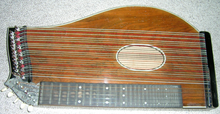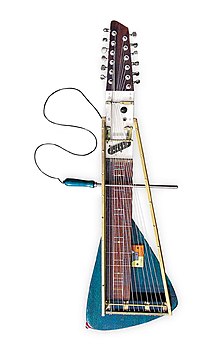m rv test to version 10:22, 25 April 2007 by RevRagnarok |
Zitherist~enwiki (talk | contribs) |
||
| Line 41: | Line 41: | ||
*[http://www.youtube.com/watch?v=VAeYt-swWG0 Zither concert video: Hungarian violin virtuoso Félix Lajkó (plays zither here) and singer Magdolna Rúzsa performs a folk song interpretation.] |
*[http://www.youtube.com/watch?v=VAeYt-swWG0 Zither concert video: Hungarian violin virtuoso Félix Lajkó (plays zither here) and singer Magdolna Rúzsa performs a folk song interpretation.] |
||
* [http://www.studia-instrumentorum.de/MUSEUM/zithern.htm "zither collection of university Leipzig"] |
* [http://www.studia-instrumentorum.de/MUSEUM/zithern.htm "zither collection of university Leipzig"] |
||
*[http://www.zitherist.com "Zitherist International"] |
|||
[[Category:Folk instruments]] |
[[Category:Folk instruments]] |
||
[[Category:String instruments]] |
[[Category:String instruments]] |
||
Revision as of 05:34, 11 May 2007

The zither is a musical string instrument, mainly used in folk music, most commonly in German-speaking Alpine Europe. Like many other stringed instruments, acoustic and electric forms exist; in the acoustic version, the strings are stretched across the length of the soundbox, and neither version has a neck. They can be divided into two classes, the
- fretted ("concert") zithers and
- fretless zithers.
A musician that plays them is called zitherist or zither player.


(For much more on fretless zithers, see the external link below.)
The name zither may be derived from the Greek word kithara, an instrument from classical times used in Ancient Greece and later throughout the Roman Empire and in the Arab world (Arabic قيثارة); the name "guitar" derives from this as well.
In entertainment, the zither is perhaps most famous for its role in providing the soundtrack and opening scene of the classic film noir The Third Man. The instrument has a prominent solo in one of Johann Strauss II's most famous waltzes, "Tales from the Vienna Woods". It is also used by multi-instrumentalist Laraaji on the third release of Brian Eno's Ambient series, Ambient 3: Day of Radiance. In more popular music, Shirley Abicair, the well known Australian born singer, popularised the zither when she used it widely as accompaniment in her popular TV shows, live performances and recordings in Britain in the 1950s and 1960s. Today, Jerusalem-based multi-instrumentalist Bradley Fish has the most widely distributed musical loops of various zithers in a multitude of styles on Sony Digital Pictures.
The word zither is also used to describe a large family of stringed instruments in which the strings do not extend beyond the sounding box. This family includes the hammered dulcimer, the psalteries, and the Appalachian dulcimer.
A very similar instrument used in India generally for vocal (raag) accompaniment is called Swarmandal.
Dutch experimental luthier Yuri Landman has created 3 different models of electric zithers all with an additional 3rd Bridge to explore the possibilities of creating harmonic overtones with a mathematical scale for the 3rd bridge positions. One was given away to Aaron Hemphill of the Liars.
History
The earliest known zither is a Chinese guqin found in the tomb of Marquis Yi of Zeng dating from 433 BC.[citation needed]
See also
Sources
- Zither from the University of Michigan School of Information's CHICO project